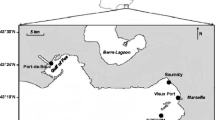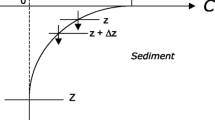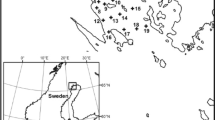Abstract
Polycyclic aromatic hydrocarbons (PAHs) are common contaminants in terrestrial and aquatic environments and can represent a significant constituent of the carbon pool in coastal sediments. We report here the results of an 18-month seasonal study of PAH biodegradation and heterotrophic bacterial production and their controlling biogeochemical factors from 186 sediment samples taken in a tidally influenced freshwater estuary. For each sampling event, measurements were averaged from 25–45 stations covering ∼250 km2. There was a clear relationship between bacterial production and ambient temperature, but none between production and bottom water dissolved oxygen (DO) % saturation or PAH concentrations. In contrast with other studies, we found no effect of temperature on the biodegradation of naphthalene, phenanthrene, or fluoranthene. PAH mineralization correlated with bottom water DO saturation above 70% (r2 > 0.99). These results suggest that the proportional utilization of PAH carbon to natural organic carbon is as much as three orders of magnitude higher during cooler months, when water temperatures are lower and DO % saturation is higher. Infusion of cooler, well-oxygenated water to the water column overlying contaminated sediments during the summer months may stimulate PAH metabolism preferentially over non-PAH organic matter.



Similar content being viewed by others
References
JO Allen JL Durant NM Dookeran K Taghizadeh EF Plummer AL Lafleur AF Sarofim KA Smith (1998) ArticleTitleMeasurement of C24H14 polycyclic aromatic hydrocarbons associated with a size-segregated urban aerosol Environ Sci Technol 32 1928–1932 Occurrence Handle10.1021/es970919r
KH Baker DS Herson (1990) ArticleTitleIn situ bioremediation of contaminated aquifers and subsurface soils Geomicrobiol J 8 133–146
HA Bamford JH Offenberg RK Larsen F-C Ko JE Baker (1999) ArticleTitleDiffusive exchange of polycyclic aromatic hydrocarbons across the air–water interface of the Patapsco River, an urbanized subestuary of the Chesapeake Bay Environ Sci Technol 33 2138–2144 Occurrence Handle10.1021/es981324e
GW Bartholomew FK Pfaender (1983) ArticleTitleInfluence of spatial and temporal variations on organic pollutant biodegradation rates in an estuarine environment Appl Environ Microbiol 45 103–109 Occurrence Handle6824312
D Bastviken L Tranvik (2001) ArticleTitleThe leucine incorporation method estimates bacterial growth equally well in both oxic and anoxic lake waters Appl Environ Microbiol 67 2916–2921 Occurrence Handle10.1128/AEM.67.7.2916-2921.2001 Occurrence Handle11425702
JE Bauer DG Capone (1985) ArticleTitleDegradation and mineralization of the polycyclic aromatic hydrocarbons anthracene and naphthalene in intertidal marine sediments Appl Environ Microbiol 50 81–90
JW Blackburn (1998) ArticleTitleBioremediation scaleup effectiveness: a review Biorem J 1 265–282
DJ Burdige CS Martens (1990) ArticleTitleBiogeochemical cycling in an organic-rich coastal marine basin: 11. The sedimentary cycling of dissolved, free amino acids Geochim Cosmochim Acta 54 3033–3052 Occurrence Handle10.1016/0016-7037(90)90120-A
DG Capone JE Bauer (1992) Microbial processes in coastal pollution R Mitchell (Eds) Environmental Microbiology Wiley-Liss New York 191–237
CE Cerniglia MA Heitkamp (1989) Microbial degradation of polycyclic aromatic hydrocarbons (PAH) in the aquatic environment U Varanasi (Eds) Metabolism of Polycyclic Aromatic Hydrocarbons in the Aquatic Environment CRC Press Boca Raton, FL 41–68
JD Coates RT Anderson DR Lovley (1996) ArticleTitleOxidation of polycyclic aromatic hydrocarbons under sulfate-reducing conditions Appl Environ Microbiol 62 1099–1101
JD Coates J Woodward J Allen P Philp DR Lovley (1997) ArticleTitleAnaerobic degradation of polycyclic aromatic hydrocarbons and alkanes in petroleum-contaminated marine harbor sediments Environ Sci Technol 63 3589–3593
RB Coffin JH Sharp (1987) ArticleTitleMicrobial trophodynamics in the Delaware Estuary Mar Ecol Prog Ser 41 253–266
TJ Cutright SY Lee (1994) ArticleTitleMicroorganisms and metabolic pathways for remediation of PAH contaminated soil Fresenius Environ Bull 3 413–421
JW Deming (1993) 14C tracer method for measuring microbial activity in deep-sea sediments PF Kemp BF Sherr EB Sherr JJ Cole (Eds) Handbook of Methods in Aquatic Microbial Ecology Lewis Publishers Ann Arbor, MI 405–414
RM Dickhut KE Gustafson (1995) ArticleTitleAtmospheric washout of polycyclic aromatic hydrocarbons in the Southern Chesapeake Bay region Environ Sci Technol 29 1518–1525 Occurrence Handle10.1021/es00006a013
M Felip ML Pace JJ Cole (1996) ArticleTitleRegulation of planktonic bacterial growth rates: the effects of temperature and resources Microb Ecol 31 15–28 Occurrence Handle10.1007/BF00175072
S Findlay ML Pace D Lints JJ Cole NF Caraco B Peierls (1991) ArticleTitleWeak coupling of bacterial and algal production in a heterotrophic ecosystem: the Hudson River estuary Limnol Oceanogr 36 268–278
JA Fisher MJ Scarlett AD Stott (1997) ArticleTitleAccelerated solvent extraction: an evaluation for screening of soils for selected U.S. EPA semivolatile organic priority pollutants Environ Sci Technol 31 1120–1127 Occurrence Handle10.1021/es9606283
TR Fisher AB Gustafson K Sellner R Lacouture LW Haas RL Wetzel R Magnien D Everitt B Michaels R Karrh (1999) ArticleTitleSpatial and temporal variation of resource limitation in Chesapeake Bay Mar Biol 133 763–778 Occurrence Handle10.1007/s002270050518
TP Franz SJ Eisenreich TM Holsen (1998) ArticleTitleDry deposition of particulate polychlorinated biphenyls and polycyclic aromatic hydrocarbons to Lake Michigan Environ Sci Technol 32 3681–3688 Occurrence Handle10.1021/es980107a
X Gayte D Fontvielle KJ Wilkinson (1999) ArticleTitleBacterial stimulation in mixed cultures of bacteria and organic carbon from river and lake waters Microb Ecol 38 285–295 Occurrence Handle10541790
JI Hedges RG Keil R Benner (1997) ArticleTitleWhat happens to terrestrial organic matter in the ocean? Org Geochem 27 195–212 Occurrence Handle10.1016/S0146-6380(97)00066-1
SE Herbes LR Schwall GA Williams (1977) ArticleTitleRate of microbial transformation of polycyclic aromatic hydrocarbons: a chromatographic quantification procedure Appl Environ Microbiol 34 244–246 Occurrence Handle907346
MP Hoch DL Kirchman (1993) ArticleTitleSeasonal and interannual variability in bacterial production and biomass in a temperate estuary Mar Ecol Prog Ser 98 283–295
JP Hudak J McDaniel S Lee JA Fuhrman (1988) ArticleTitleMineralization potentials of aromatic hydrocarbons by estuarine microorganisms: variations with season, location, and bacterioplankton production Mar Ecol Prog Ser 47 97–102
M Kästner M Breuer-Jammali B Mahro (1998) ArticleTitleImpact of inoculation protocols, salinity, and pH on the degradation of polycyclic aromatic hydrocarbons (PAHs) and survival of PAH-degrading bacteria introduced into soil Appl Environ Microbiol 64 359–362 Occurrence Handle9435090
M Kästner M Breuer-Jammali B Mahro (1994) ArticleTitleEnumeration and characterization of the soil microflora from hydrocarbon-contaminated soil sites able to mineralize polycyclic aromatic hydrocarbons (PAH) Appl Microbiol Biotechnol 41 267–273 Occurrence Handle10.1007/s002530050142
RP Kerr DG Capone (1988) ArticleTitleThe effect of salinity on the microbial mineralization of 2 polycyclic aromatic-hydrocarbons in estuarine sediments Mar Environ Res 26 181–198 Occurrence Handle10.1016/0141-1136(88)90026-8
H Kim HF Hemon LR Krumholz BA Cohen (1995) ArticleTitleIn-situ biodegradation of toluene in a contaminated stream. 1. Field studies Environ Sci Technol 29 108–116 Occurrence Handle10.1021/es00001a014
DL Kirchman (1993) Leucine incorporation as a measure of biomass production by heterotrophic bacteria PF Kemp BF Sherr EB Sherr JJ Cole (Eds) Handbook of Methods in Aqautic Microbial Ecology Lewis Publishers Boca Raton, FL 509–512
AKT Kirschner B Velimirov (1999) ArticleTitleBenthic bacterial secondary production measured via simultaneous 3H-thymidine and 14C-leucine incorporation, and its implication for the carbon cycle of a shallow macrophyte-dominated backwater system Limnol Oceanogr 44 1871–1881
JS Latimer WR Davis DJ Keith (1999) ArticleTitleMobilization of PAHs and PCBs from in-place contaminated marine sediments during simulated resuspension events Estuar Coast Shelf Sci 49 577–595 Occurrence Handle10.1006/ecss.1999.0516
GG Leppard DT Flannigan D Mavrocordatos CH Marvin DW Bryant BE McCarry (1998) ArticleTitleBinding of polycyclic aromatic hydrocarbons by size classes of particulate in Hamilton Harbor water Environ Sci Technol 32 3633–3639 Occurrence Handle10.1021/es980055p
E Lipiatou I Tolosa R Simo I Bouloubassi J Dachs S Marti M-A Sicre JM Bayona JO Grimalt A Saliot J Albaigés (1997) ArticleTitleMass budget and dynamics of polycyclic aromatic hydrocarbons in the Mediterranean Sea Deep-Sea Res Part II 44 881–905 Occurrence Handle10.1016/S0967-0645(96)00093-8
DR Lovley (2001) ArticleTitleBioremediation—anaerobes to the rescue Science 293 1444–1446 Occurrence Handle10.1126/science.1063294 Occurrence Handle11520973
E Manoli C Samara (1999) ArticleTitlePolycyclic aromatic hydrocarbons in natural waters: sources, occurrence and analysis TRAC—Trends Anal Chem 18 417–428 Occurrence Handle10.1016/S0165-9936(99)00111-9
KA Maruya RW Risebrough AJ Horne (1996) ArticleTitlePartitioning of polynuclear aromatic hydrocarbons between sediments from San Francisco Bay and their porewaters Environ Sci Technol 30 2942–2947 Occurrence Handle10.1021/es950909v
JR Maxted RA Eskin SB Weisberg FW Kutz (1997) ArticleTitleThe ecological condition of dead-end canals of the Delaware and Maryland coastal bays Estuaries 20 319–327
AE McElroy JW Farrington JM Teal (1989) Bioavailability of polycyclic aromatic hydrocarbons in the aquatic environment U Varanasi (Eds) Metabolism of Polycyclic Aromatic Hydrocarbons in the Aquatic Environment CRC Press Boca Raton, FL 1–39
SE McGroddy JW Farrington PM Gschwend (1996) ArticleTitleComparison of the in situ and desorption sediment–water partitioning of polycyclic aromatic hydrocarbons and polychlorinated biphenyls Environ Sci Technol 30 172–177 Occurrence Handle10.1021/es950218z
D Muncnerova J Augustin (1993) ArticleTitlePhysical and chemical aspects affecting the process of biodegradation of xenobiotics of the type of aromates Chemicke Listy 87 484–492
National Research Council (1993) In Situ Bioremediation: When Does It Work? 1–207
B Ngabe TF Bidleman GI Scott (2000) ArticleTitlePolycyclic aromatic hydrocarbons in storm runoff from urban and coastal South Carolina Sci Total Environ 255 1–9 Occurrence Handle10.1016/S0048-9697(00)00422-8 Occurrence Handle10898390
FK Pfaender GW Bartholomew (1982) ArticleTitleMeasurement of aquatic biodegradation rates by determing heterotrophic uptake of radiolabeled pollutants Appl Environ Microbiol 44 159–164 Occurrence Handle7125647
JW Pohlman RB Coffin CS Mitchell MT Montgomery BJ Spargo JK Steele TJ Boyd (2002) ArticleTitleTransport, deposition and biodegradation of particle bound polycyclic aromatic hydrocarbons in a tidal basin of an industrial watershed Environ Monit Assess 75 155–167 Occurrence Handle10.1023/A:1014435830558 Occurrence Handle12002284
MM Rothermich LA Hayes DR Lovley (2002) ArticleTitleAnaerobic, sulfate-dependent degradation of polycyclic aromatic hydrocarbons in petroleum-contaminated harbor sediment Environ Sci Technol 36 4811–4817 Occurrence Handle10.1021/es0200241 Occurrence Handle12487304
LC Schaffner RM Dickhut S Mitra PW Lay C Brouwer-Riel (1997) ArticleTitleEffects of physical chemistry and bioturbation by estuarine macrofauna on the transport of hydrophobic organic contaminants in the benthos Environ Sci Technol 31 3120–3125 Occurrence Handle10.1021/es970054h
Sediment Management Work Group (1999) Contaminated Sediment Management Technical Papers, 1–37
F-K Shiah HW Ducklow (1994) ArticleTitleTemperature regulation of heterotrophic bacterioplankton abundance, production, and specific growth rate in Chesapeake Bay Limnol Oceanogr 39 1243–1258
MP Shiaris (1989) ArticleTitlePhenanthrene mineralization along a natural salinity gradient in an urban estuary, Boston Harbor, Massachusetts Microb Ecol 18 135–146
MP Shiaris (1989) ArticleTitleSeasonal biotransformation of naphthalene, phenanthrene, and benzo [a] pyrene in surficial estuarine sediments Appl Environ Microbiol 55 1391–1399
DC Smith F Azam (1992) ArticleTitleA simple, economical method for measuring bacterial protein synthesis rates in seawater using 3H-leucine Mar Microb Food Webs 6 107–114
AC Steyermark JR Spotila D Gillette H Isseroff (1999) ArticleTitleBiomarkers indicate health problems in brown bullheads from the industrialized Schuylkill River, Philadelphia Trans Am Fish Soc 128 328–338 Occurrence Handle10.1577/1548-8659(1999)128<0328:BIHPIB>2.0.CO;2
L Tuominen (1995) ArticleTitleComparison of leucine uptake methods and a thymidine incorporation method for measuring bacterial activity in sediment J Microbiol Methods 24 125–134 Occurrence Handle10.1016/0167-7012(95)00062-3
U.S. Environmental Protection Agency (1998) Contaminated Sediment Management Strategy. EPA 823-R-98-001
UNESCO (1994) Determination of POC and PON. Protocols for JGOFS Core Measurements 101–103
United States Environmental Protection Agency (1997) The Incidence and Severity of Sediment Contamination in Surface Waters of the United States. Vol 1. National Sediment Quality Survey. EPA 823-R-97-006
TIR Utvik S Johnsen (1999) ArticleTitleBioavailability of polycyclic aromatic hydrocarbons in the North Sea Environ Sci Technol 33 1963–1969 Occurrence Handle10.1021/es9804215
PC Metre Particlevan BJ Mahler ET Furlong (2000) ArticleTitleUrban sprawl leaves its PAH signature Environ Sci Technol 34 4064–4070 Occurrence Handle10.1021/es991007n
SB Weisberg WH Burton (1993) ArticleTitleSpring distribution and abundance of ichthyoplankton in the tidal Delaware River Fish Bull 91 788–797
AR Zimmerman EA Canuel (2000) ArticleTitleA geochemical record of eutrophication and anoxia in Chesapeake Bay sediments: anthropogenic influence on organic matter composition Mar Chem 69 117–137 Occurrence Handle10.1016/S0304-4203(99)00100-0
Acknowledgments
This work was funded by the NRL CORE Work Unit 61-7619/61153N MA013-01-44. The opinions and assertions contained herein are not to be construed as official or reflecting the views of the U.S. Navy or the naval service at large. The authors thank D.L. Kirchman for helpful comments on this manuscript, the captain, crew, and support personnel of the R/V Cape Henlopen, and Inactive Ships at the Philadelphia Naval Complex for logistical assistance during this project.
Author information
Authors and Affiliations
Corresponding author
Rights and permissions
About this article
Cite this article
Boyd, T., Montgomery, M., Steele, J. et al. Dissolved Oxygen Saturation Controls PAH Biodegradation in Freshwater Estuary Sediments. Microb Ecol 49, 226–235 (2005). https://doi.org/10.1007/s00248-004-0279-0
Received:
Accepted:
Published:
Issue Date:
DOI: https://doi.org/10.1007/s00248-004-0279-0




